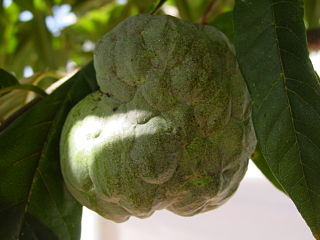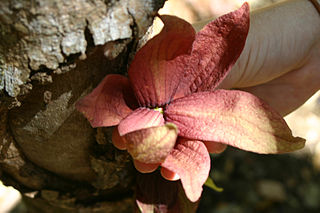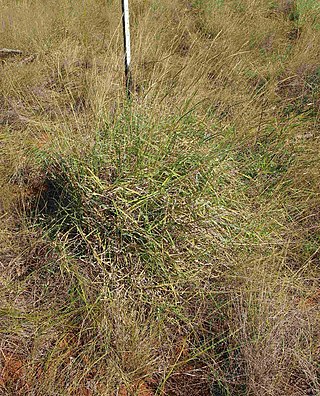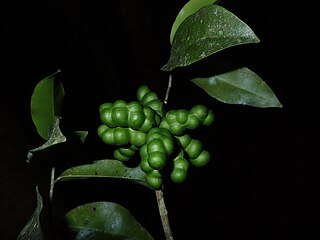
The Annonaceae are a family of flowering plants consisting of trees, shrubs, or rarely lianas commonly known as the custard apple family or soursop family. With 108 accepted genera and about 2400 known species, it is the largest family in the Magnoliales. Several genera produce edible fruit, most notably Annona, Anonidium, Asimina, Rollinia, and Uvaria. Its type genus is Annona. The family is concentrated in the tropics, with few species found in temperate regions. About 900 species are Neotropical, 450 are Afrotropical, and the remaining are Indomalayan.

Sapranthus is a genus of flowering woody plants in the family Annonaceae. The genus was first described in 1866 by Berthold Carl Seemann.
Hexalobus mossambicensis is a species of plant in the Annonaceae family. It is endemic to Mozambique.

Hexalobus is a genus of flowering plants in the family Annonaceae. There are five species native to tropical Africa.
Hexalobus salicifolius is a species of flowering plant in the family Annonaceae. It is found in Cameroon, Ivory Coast, Gabon, and the Republic of the Congo. Local common names include oouè, owoé, and owui.
Neostenanthera is a genus of flowering plant in the Annonaceae family. All discovered species are native to continental Africa. It contains the following species, according to The Plant List:

Polyceratocarpus is a genus of flowering plants in the family Annonaceae. All known species are native to continental Africa.

Uvariopsis is a genus of flowering plants in the family Annonaceae. The genus is unique to Africa, and consists of about 18 species, all of which are either ramiflorous, cauliflorous or both.
Uvariopsis vanderystii is a species of plant in the Annonaceae family. It is found in Cameroon, the Democratic Republic of the Congo, and Gabon. Its natural habitat is subtropical or tropical moist lowland forests. It is threatened by habitat loss.

Mnesithea, or jointtail grass, is a genus of Asian, Australian, and Pacific Island plants in the grass family. The number of species placed in the genus varied considerably as of November 2024 depending in large part on how the genus Coelorachis was treated. Sources that synonymized Coelorachis with Mnesithea accepted about 26 species. Those that synonymized Coelorachis with Rottboellia accepted about seven.
Hornschuchia is a genus of flowering plants in the custard apple and soursop family Annonaceae, with all species native to South America and in eastern Brazil. It is within the Bocageeae tribe.
Mischogyne is a genus of plants in the family Annonaceae. It comprises five species distributed in Angola, Cameroon, Gabon, Ghana, Guinea, Guinea-Bissau, Ivory Coast, Liberia, Nigeria, Sierra Leone, Democratic Republic of the Congo. Arthur Wallis Exell the British botanist who first formally described the genus named it after the stalks that bears its reproductive structures.

The Malmeoideae are a subfamily of trees and other plants of the family Annonaceae.
Brieya is a genus of flowering plants belonging to the family Annonaceae.
Ephedranthus is a genus of flowering plants belonging to the family Annonaceae.
Ruizodendron is a monotypic genus of flowering plants belonging to the family Annonaceae. It is part of Malmeoideae subfamily and Malmeeae tribe. The only known species is Ruizodendron ovale.

Annickia chlorantha is a tree that grows up to 25 meters tall, it belongs to the Annonaceae family. An important tree used in traditional medical practices for the treatment of malaria and various diseases in Nigeria and Cameroon; oil extracted from stem barks and leaves of the species and Annickia affinis, its more common close kin have been widely studied.

Annickia affinis is small to medium sized tree that grows up to 30m tall, it belongs to the Annonaceae family. Also known as the African yellow wood, it is widely used in Central Africa and parts of West Africa in the treatment of various diseases. Both Annickia affinis and Annickia chlorantha are widely studied and sometimes credited with the name Enantia chrlorantha.
Annickia polycarpa is a small to medium-sized tree found in evergreen forests of West and Central Africa, it is within the Annonaceae family. It is also called the African Yellow wood.

Uvariopsis congensis is a species of plant in the Annonaceae family. It is native to Angola, Cameroon, the Central African Republic, the Democratic Republic of the Congo, Gabon, Ivory Coast, Kenya, Sudan, Uganda, Zambia. Walter Robyns and Jean Ghesquière, the botanists who first formally described the species, named it after the Belgian Congo, now called the Democratic Republic of the Congo, where the specimen they examined was collected in the town of Kisantu near the Inkisi River.










